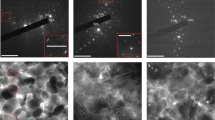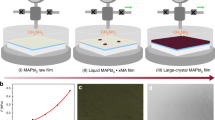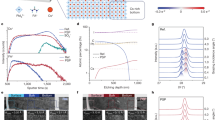Abstract
The composition of perovskite has been optimized combinatorially such that it often contains six components (AxByC1−x−yPbXzY3−z) in state-of-art perovskite solar cells. Questions remain regarding the precise role of each component, and the lack of a mechanistic explanation limits the practical exploration of the large and growing chemical space. Here, aided by transient photoluminescence microscopy, we find that, in perovskite single crystals, carrier diffusivity is in fact independent of composition. In polycrystalline thin films, the different compositions play a crucial role in carrier diffusion. We report that methylammonium (MA)-based films show a high carrier diffusivity of 0.047 cm2 s−1, while MA-free mixed caesium-formamidinium (CsFA) films exhibit an order of magnitude lower diffusivity. Elemental composition studies show that CsFA grains display a graded composition. This curtails electron diffusion in these films, as seen in both vertical carrier transport and surface potential studies. Incorporation of MA leads to a uniform grain core-to-edge composition, giving rise to a diffusivity of 0.034 cm2 s−1 in CsMAFA films. A model that invokes competing crystallization processes allows us to account for this finding, and suggests further strategies to achieve homogeneous crystallization for the benefit of perovskite optoelectronics.
This is a preview of subscription content, access via your institution
Access options
Access Nature and 54 other Nature Portfolio journals
Get Nature+, our best-value online-access subscription
$29.99 / 30 days
cancel any time
Subscribe to this journal
Receive 12 print issues and online access
$259.00 per year
only $21.58 per issue
Buy this article
- Purchase on Springer Link
- Instant access to full article PDF
Prices may be subject to local taxes which are calculated during checkout





Similar content being viewed by others
Data availability
The authors declare that the main data supporting the findings of this study are available within the article and its Supplementary information. Extra data are available from the authors upon request.
References
Kojima, A., Teshima, K., Shirai, Y. & Miyasaka, T. Organometal halide perovskites as visible-light sensitizers for photovoltaic cells. J. Am. Chem. Soc. 131, 6050–6051 (2009).
Im, J.-H., Lee, C.-R., Lee, J.-W., Park, S.-W. & Park, N.-G. 6.5% efficient perovskite quantum-dot-sensitized solar cell. Nanoscale 3, 4088 (2011).
Kim, H.-S. et al. Lead iodide perovskite sensitized all-solid-state submicron thin film mesoscopic solar cell with efficiency exceeding 9%. Sci. Rep. 2, 591 (2012).
Lee, M. M., Teuscher, J. J., Miyasaka, T., Murakami, T. N. & Snaith, H. J. Efficient hybrid solar cells based on meso-superstructured organometal halide perovskites. Science 338, 643–647 (2012).
Burschka, J. et al. Sequential deposition as a route to high-performance perovskite-sensitized solar cells. Nature 499, 316–320 (2013).
Best Research-Cell Efficiency Chart (NREL, accessed 10 October 2019); https://www.nrel.gov/pv/cell-efficiency.html
deQuilettes, D. W. et al. Impact of microstructure on local carrier lifetime in perovskite solar cells. Science 348, 683–686 (2015).
Hou, Y. et al. A generic interface to reduce the efficiency-stability-cost gap of perovskite solar cells. Science 358, 1192–1197 (2017).
Guo, Z. et al. Long-range hot-carrier transport in hybrid perovskites visualized by ultrafast microscopy. Science 356, 59–62 (2017).
Davies, C. L. et al. Bimolecular recombination in methylammonium lead triiodide perovskite is an inverse absorption process. Nat. Commun. 9, 293 (2018).
Abdi-Jalebi, M. et al. Maximizing and stabilizing luminescence from halide perovskites with potassium passivation. Nature 555, 497–501 (2018).
Tsai, H. et al. High-efficiency two-dimensional Ruddlesden–Popper perovskite solar cells. Nature 536, 312–316 (2016).
Dastidar, S. et al. High chloride doping levels stabilize the perovskite phase of cesium lead iodide. Nano Lett. 16, 3563–3570 (2016).
Cho, H. et al. Overcoming the electroluminescence efficiency limitations of perovskite light-emitting diodes. Science 350, 1222–1225 (2015).
Wang, T. et al. Indirect to direct bandgap transition in methylammonium lead halide perovskite. Energy Environ. Sci. 10, 509–515 (2017).
Schulz, P. et al. Electronic level alignment in inverted organometal perovskite solar cells. Adv. Mater. Interfaces 2, 1400532 (2015).
Pellet, N. et al. Mixed-organic-cation perovskite photovoltaics for enhanced solar-light harvesting. Angew. Chem. Int. Ed. Engl. 53, 3151–3157 (2014).
Li, Z. et al. Stabilizing perovskite structures by tuning tolerance factor: formation of formamidinium and cesium lead iodide solid-state alloys. Chem. Mater. 28, 284–292 (2016).
McMeekin, D. P. et al. A mixed-cation lead mixed-halide perovskite absorber for tandem solar cells. Science 351, 151–155 (2016).
Saliba, M. et al. Cesium-containing triple cation perovskite solar cells: improved stability, reproducibility and high efficiency. Energy Environ. Sci. 9, 1989–1997 (2016).
Jeon, N. J. et al. Compositional engineering of perovskite materials for high-performance solar cells. Nature 517, 476–480 (2015).
Tan, H. et al. Dipolar cations confer defect tolerance in wide-bandgap metal halide perovskites. Nat. Commun. 9, 3100 (2018).
Yang, W. S. et al. Iodide management in formamidinium-lead-halide–based perovskite layers for efficient solar cells. Science 356, 1376–1379 (2017).
Lin, K. et al. Perovskite light-emitting diodes with external quantum efficiency exceeding 20 per cent. Nature 562, 245–248 (2018).
Correa-Baena, J.-P. et al. Homogenized halides and alkali cation segregation in alloyed organic-inorganic perovskites. Science 363, 627–631 (2019).
Dang, H. X. et al. Multi-cation synergy suppresses phase segregation in mixed-halide perovskites. Joule 3, 1746–1764 (2019).
Akselrod, G. M. et al. Visualization of exciton transport in ordered and disordered molecular solids. Nat. Commun. 5, 3646 (2014).
Shi, D. et al. Low trap-state density and long carrier diffusion in organolead trihalide perovskite single crystals. Science 347, 519–522 (2015).
Dong, Q. et al. Electron-hole diffusion lengths >175 µm in solution-grown CH3NH3PbI3 single crystals. Science 347, 967–970 (2015).
Pazos-Outon, L. M. et al. Photon recycling in lead iodide perovskite solar cells. Science 351, 1430–1433 (2016).
Yang, Y. et al. Top and bottom surfaces limit carrier lifetime in lead iodide perovskite films. Nat. Energy 2, 16207 (2017).
Ščajev, P. et al. Two regimes of carrier diffusion in vapor-deposited lead-halide perovskites. J. Phys. Chem. C Nanomater. Interfaces 121, 21600–21609 (2017).
Guo, Z., Manser, J. S., Wan, Y., Kamat, P. V. & Huang, L. Spatial and temporal imaging of long-range charge transport in perovskite thin films by ultrafast microscopy. Nat. Commun. 6, 7471 (2015).
Xing, G. et al. Long-range balanced electron- and hole-transport lengths in organic-inorganic CH3NH3PbI3. Science 342, 344–347 (2013).
Stranks, S. D. et al. Electron-hole diffusion lengths exceeding 1 micrometer in an organometal trihalide perovskite absorber. Science 342, 341–344 (2013).
Jeon, N. J. et al. Solvent engineering for high-performance inorganic–organic hybrid perovskite solar cells. Nat. Mater. 13, 897–903 (2014).
Delor, M., Weaver, H. L., Yu, Q. & Ginsberg, N. S. Imaging material functionality through 3D nanoscale tracking of energy flow. Nat. Mater. 19, 56–62 (2020).
deQuilettes, D. W. et al. Tracking photoexcited carriers in hybrid perovskite semiconductors: trap-dominated spatial heterogeneity and diffusion. ACS Nano 11, 11488–11496 (2017).
Yang, M. et al. Do grain boundaries dominate non-radiative recombination in CH3NH3PbI3 perovskite thin films? Phys. Chem. Chem. Phys. 19, 5043–5050 (2017).
Arias, D. H., Moore, D. T., Van De Lagemaat, J. & Johnson, J. C. Direct measurements of carrier transport in polycrystalline methylammonium lead iodide perovskite films with transient grating spectroscopy. J. Phys. Chem. Lett. 9, 5710–5717 (2018).
Cho, K. T. et al. Highly efficient perovskite solar cells with a compositionally engineered perovskite/hole transporting material interface. Energy Environ. Sci. 10, 621–627 (2017).
Luo, D. et al. Enhanced photovoltage for inverted planar heterojunction perovskite solar cells. Science 360, 1442–1446 (2018).
Shin, S. S. et al. Colloidally prepared La-doped BaSnO3 electrodes for efficient, photostable perovskite solar cells. Science 6620, 167–171 (2017).
Turren-Cruz, S.-H., Hagfeldt, A. & Saliba, M. Methylammonium-free, high-performance, and stable perovskite solar cells on a planar architecture. Science 362, 449–453 (2018).
Saidaminov, M. I. et al. Suppression of atomic vacancies via incorporation of isovalent small ions to increase the stability of halide perovskite solar cells in ambient air. Nat. Energy 3, 648–654 (2018).
Nazarenko, O., Yakunin, S., Morad, V., Cherniukh, I. & Kovalenko, M. V. Single crystals of caesium formamidinium lead halide perovskites: solution growth and gamma dosimetry. NPG Asia Mater. 9, e373 (2017).
Kadro, J. M., Nonomura, K., Gachet, D., Grätzel, M. & Hagfeldt, A. Facile route to freestanding CH3NH3PbI3 crystals using inverse solubility. Sci. Rep. 5, 11654 (2015).
Quintero-Bermudez, R. et al. Compositional and orientational control in metal halide perovskites of reduced dimensionality. Nat. Mater. 17, 900–907 (2018).
Acknowledgements
Material growth and characterization were supported by the US Department of the Navy, Office of Naval Research (grant award no. N00014-17-1-2524). Carrier diffusion imaging studies at MIT were supported by the US Department of Energy, Office of Science, Office of Basic Energy Sciences, under award no. DE-SC0019345. M.I.S. acknowledges the support of the Banting Postdoctoral Fellowship Program, administered by the Government of Canada. G.W. acknowledges support from the Natural Sciences and Engineering Research Council of Canada (NSERC). We thank R. Wolowiec, D. Kopilovic, L. Levina and E. Palmiano for their help during the course of the study, and P. Brodersen for performing XPS.
Author information
Authors and Affiliations
Contributions
M.I.S. and K.W. conceived the idea. M.I.S. and M.W. prepared samples and characterized them. K.W. analysed carrier diffusion imaging results and developed the model. A.J., R.Q.B., M.V., A.P., Y.H., J. P., G.W. and S.O.K. assisted with the experiments and discussions. W.A.T. and E.H.S. directed the overall research. M.I.S., K.W., W.A.T. and E.H.S. wrote the manuscript. All authors read and commented on the manuscript.
Corresponding authors
Ethics declarations
Competing interests
The authors declare no competing interests.
Additional information
Publisher’s note Springer Nature remains neutral with regard to jurisdictional claims in published maps and institutional affiliations.
Supplementary information
Supplementary information
Supplementary Figs. 1–18, Methods 1.1–1.8 and 2.1–2.2, Tables 1–4 and refs. 1–9.
Supplementary Video 1
Two-dimensional carrier diffusion in MAPbI3 single crystal.
Rights and permissions
About this article
Cite this article
Saidaminov, M.I., Williams, K., Wei, M. et al. Multi-cation perovskites prevent carrier reflection from grain surfaces. Nat. Mater. 19, 412–418 (2020). https://doi.org/10.1038/s41563-019-0602-2
Received:
Accepted:
Published:
Issue Date:
DOI: https://doi.org/10.1038/s41563-019-0602-2
This article is cited by
-
Redox mediator-stabilized wide-bandgap perovskites for monolithic perovskite-organic tandem solar cells
Nature Energy (2024)
-
Regulating surface potential maximizes voltage in all-perovskite tandems
Nature (2023)
-
Synergistic strain engineering of perovskite single crystals for highly stable and sensitive X-ray detectors with low-bias imaging and monitoring
Nature Photonics (2022)
-
Picturing charge carrier diffusion
Nature Materials (2022)
-
Efficient vertical charge transport in polycrystalline halide perovskites revealed by four-dimensional tracking of charge carriers
Nature Materials (2022)



